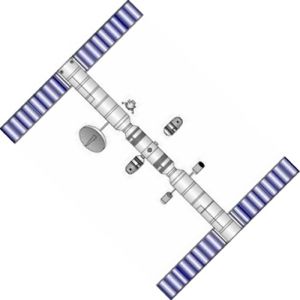
Home - Search - Browse - Alphabetic Index: 0- 1- 2- 3- 4- 5- 6- 7- 8- 9
A- B- C- D- E- F- G- H- I- J- K- L- M- N- O- P- Q- R- S- T- U- V- W- X- Y- Z
TKS Heavy Space Station
 TKS - TOSZ |
AKA: Heavy Orbital Earth Space Station. Status: Study 1961. Gross mass: 150,000 kg (330,000 lb). Height: 52.00 m (170.00 ft). Span: 4.50 m (14.70 ft).
The draft project was completed on 3 May 1961 and marked the beginning of a long struggle throughout the 1960's to get such a station built and launched.
The station was designed to conduct the following missions:
- Scientific research
- Astronomical
- Geophysical
- Medical-biological
- Military operations
- Weather surveillance
- Arctic surveillance
- Communications
- Cartography
- Electronic intelligence
- Photoreconnaissance
- Interorbital combat
- Antisatellite
- Nuclear bombardment
The core module of the station would be placed into orbit on the very first launch of the N1, planned in the original N1 draft project for 1965. The following development flights would be used as well to deliver two to three 50 metric ton station modules. These would be docked in orbit to form a single station. The crew would ferry to the station using spacecraft launched by Molniya 8K78-derived launch vehicles (i.e. what would later be Voskhod or Soyuz boosters). After a period of autonomous earth-orbit operations the ferry craft would dock with the TKS.
Crews would rotate on a monthly cycle. The ferry craft would bring with the crew the required monthly amounts of orientation system propellants, food, water, spare parts, and oxygen regeneration chemicals. After completion of their one month tour of duty, the cosmonauts would re-enter their ferry craft, separate from the TKS, conduct a retro-fire to brake out of earth orbit, and return to earth in a re-entry capsule.
The station's guidance would keep it pointed at the sun and it would rotate to produce artificial gravity in the living quarters. The basically cylindrical station would be festooned with solar panels, radio antennae, and optical devices. The station was designed so that it could be set into rotation for artificial gravity or stopped for zero-G or docking operations. Solar panels and/or a nuclear reactor would be used to provide electrical power.
The station consisted of three hermetically sealed modules, accessed via a common transition section. Two of the modules consisted of the living quarters. Diameter of each module was 4.5 meters, with a length of the cylindrical portion of 20 meters. The central module had a diameter of 4.15 m and a length of 12 m. It connected the two living modules and provided four docking ports/airlocks in its middle compartment. Either side of the airlock were two floors of equipment compartments, where tools and spare parts were stored. A central shaft of 1 meter diameter ran the length of the module, connecting the living quarters and with hatches to the equipment compartments. The hatch arrangement meant that the station could be closed off into five separate hermetically sealed areas in an emergency.
The base of the central module was ringed with blinds and radiators of the thermo-regulation system. Mounted outside of the station were small television-equipped robots, with manipulator arms, that could be moved to any part of the station to conduct necessary work or repairs by remote control.
The ferry craft were essentially like the later Soyuz, except that the capsule seems to have been mounted at the front of the spacecraft. The design consisted, from front-to-rear, of a headlight-shaped re-entry vehicle, a docking and rendezvous equipment section with the braking rocket installation, and a propellant section. At the rear of the re-entry vehicle was a hatch for entry and exit of the crew.
The TKS was the forerunner of a series of large manned military stations that Korolev promoted throughout the remainder of his life as a means of obtaining military funding for development of the N1.
Crew Size: 3.
Family: Soviet Space Stations, Space station, Space station orbit. Country: Russia. Launch Vehicles: N1, N1 1969. Agency: Korolev bureau. Bibliography: 283.
1961 May 3 - . Launch Vehicle: N1.
- The draft project of the TKS Heavy Space Station was completed - . Nation: Russia. Related Persons: Korolev. Spacecraft Bus: OS. Spacecraft: TKS Heavy Space Station. Also known as TOSZ - Heavy Orbital Station of the Earth, this was Korolev's first 1961 project for a large N1-launched military space station..
Back to top of page
Home - Search - Browse - Alphabetic Index: 0- 1- 2- 3- 4- 5- 6- 7- 8- 9
A- B- C- D- E- F- G- H- I- J- K- L- M- N- O- P- Q- R- S- T- U- V- W- X- Y- Z
© 1997-2019 Mark Wade - Contact
© / Conditions for Use